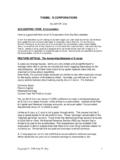Transcription of Securities Lending CWAD version - Clearwater Advisors
1 Securities Lending Executive Summary In today s capital markets, investors with large portfolios always seek opportunities to maximize liquidity and return while preserving principal value. Securities Lending offers just such an opportunity for many institutional investors including corporate investors. In Securities Lending transactions, Securities held within investment portfolios are frequently lent to parties willing to pay to borrow them. These transactions, sometimes called repurchase agreements (repos), loans and sell-buyback arrangements, are generically described as Securities Lending .
2 A Securities Lending program for a corporate cash portfolio is similar in structure and risk to a program for a pension plan or insurance company, with accounting considerations being the notable exception. Introduction The basic transaction in Securities Lending is a collateralized loan, where the company borrows money from a brokerage firm at a very low rate (a rate that is much below market levels and may even approach 0%) collateralized by one or more Securities held in the company s portfolio. Participants Brokerage firms that need specific Securities in order to meet a delivery obligation or speculators that want to carry short positions in specific Securities are willing to lend money to an investor that holds the desired Securities in its investment portfolio at a below-market rate to gain access to that security.
3 Firms seeking to prevent outright settlement failures, when a counterparty fails to deliver promised Securities , will borrow Securities overnight. Other reasons for borrowing Securities include derivative or cash hedging and arbitrage transactions. The primary lenders of Securities (borrowers of below-market rate cash) are large, institutional investors such as corporations, pension funds, insurance companies and mutual funds that are typically longer-term holders of Securities . Why a Securities Lending Program? The underlying motivation for a company to start a Securities Lending program is the opportunity to earn incremental income with marginal additional risk.
4 When a company borrows against Securities that would otherwise be held idle in the portfolio, the company receives cash at a borrowing rate that is lower than overnight money market fund rates. This cash can be reinvested in overnight funds or in other investments, resulting in net positive interest income to the investor. This additional income can have a significant impact on a corporate cash portfolio, where even a small improvement in portfolio performance can have a noticeable impact on company earnings.
5 Securities Lending can also be a liquidity tool. If a company needs to raise cash without realizing losses from selling Securities , it can borrow against Securities in the portfolio at below market rates to meet the short-term cash requirement. The company may then sell the Securities in a more favorable market environment. Fundamentals Securities borrowers are generally required to provide collateral to assure the performance of their redelivery obligation. The two main types of collateral used are: (1) cash and (2) other Securities .
6 2 Securities Lending In corporate cash security Lending programs, cash is almost always provided as collateral. This cash is typically reinvested in a short-term fund specifically designed for Securities Lending collateral, at some premium over the borrowing rate on the cash collateral. No investor would lend Securities if the borrowing rate were higher than uncollateralized alternatives, as the only motivation for Lending Securities is to earn a positive spread over the borrowing rate on cash collateral.
7 In terms of net income, a Securities Lending program should always increase portfolio income. Although there are also some increased risks, which will be addressed below, Securities Lending is generally seen as a low risk, positive value proposition. Role of the Custody Bank Securities Lending has become widely viewed as an add-on to services provided by custody banks. Banks will lend Securities on behalf of corporations whose portfolios they hold. Custodians use their infrastructure, including personnel and systems, to manage a large-scale Securities Lending program.
8 Offering Securities Lending services enables custodians to increase revenue from their custody clients while providing the client an opportunity to earn incremental income with limited risk. In an effort to keep things simple, most custodians run the entire Securities Lending program for their clients, including the reinvestment of cash collateral. Securities are only lent when a positive spread can be earned between the collateral rate and a market interest rate. This spread is known as Lending revenue and the client generally sees the total Lending revenue figure rather than a detailed breakdown of all borrowing and Lending rates and individual transactions.
9 Negotiating a Securities Lending Program Securities Lending can be the most profitable part of a custody relationship for the bank. It can also be a valuable source of additional income for the custody client. A company can extract significant cost savings and potentially defray 100% of custody costs (or more) by entering into a Securities Lending program with its custodian or a more cost effective third-party lender. The custody bank is compensated for managing a Securities Lending portfolio via a revenue split negotiated at program inception.
10 Not all portfolios are equally lendable . Securities Lending revenue depends on the demand for particular Securities . Lending collateral of lesser quality can produces higher Lending spreads. Similarly the interest rate spread earned by a Securities lender is higher when there is greater demand for the security to be borrowed resulting in more value to the Securities Lending program. Securities Lending Revenue Split The fee split between client and Lending agent can vary considerably although in almost all cases the client receives the majority of the fee.





